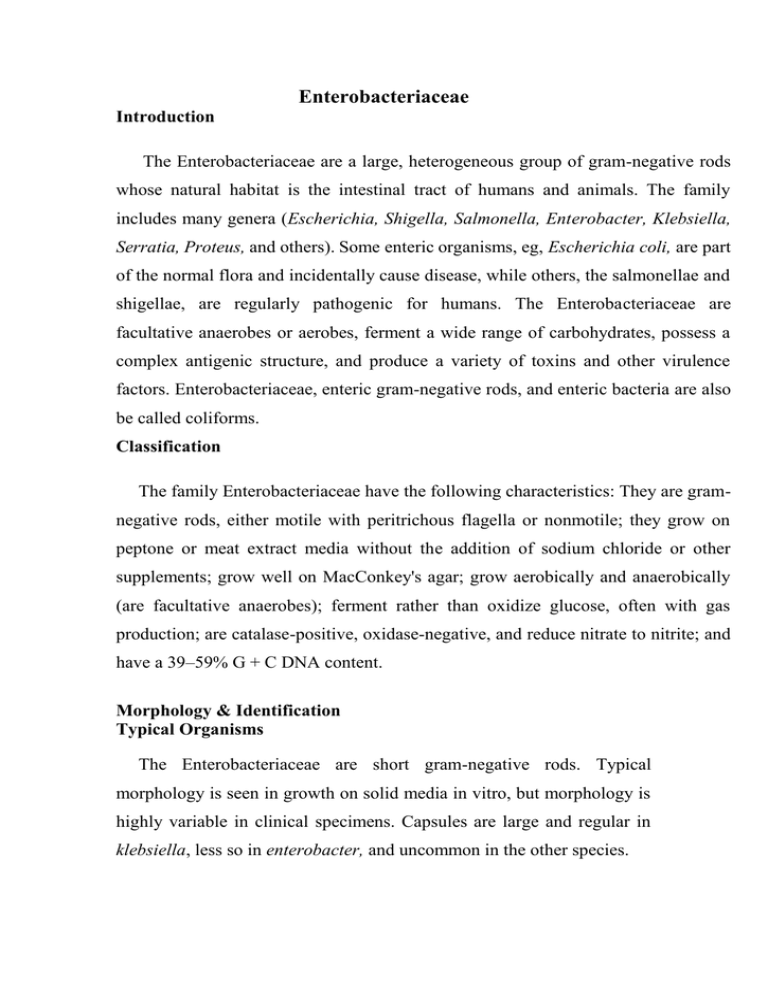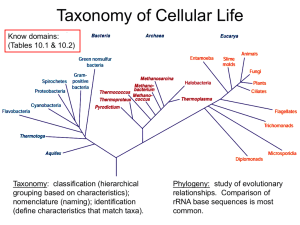Enterobacteriaceae
advertisement

Enterobacteriaceae Introduction The Enterobacteriaceae are a large, heterogeneous group of gram-negative rods whose natural habitat is the intestinal tract of humans and animals. The family includes many genera (Escherichia, Shigella, Salmonella, Enterobacter, Klebsiella, Serratia, Proteus, and others). Some enteric organisms, eg, Escherichia coli, are part of the normal flora and incidentally cause disease, while others, the salmonellae and shigellae, are regularly pathogenic for humans. The Enterobacteriaceae are facultative anaerobes or aerobes, ferment a wide range of carbohydrates, possess a complex antigenic structure, and produce a variety of toxins and other virulence factors. Enterobacteriaceae, enteric gram-negative rods, and enteric bacteria are also be called coliforms. Classification The family Enterobacteriaceae have the following characteristics: They are gramnegative rods, either motile with peritrichous flagella or nonmotile; they grow on peptone or meat extract media without the addition of sodium chloride or other supplements; grow well on MacConkey's agar; grow aerobically and anaerobically (are facultative anaerobes); ferment rather than oxidize glucose, often with gas production; are catalase-positive, oxidase-negative, and reduce nitrate to nitrite; and have a 39–59% G + C DNA content. Morphology & Identification Typical Organisms The Enterobacteriaceae are short gram-negative rods. Typical morphology is seen in growth on solid media in vitro, but morphology is highly variable in clinical specimens. Capsules are large and regular in klebsiella, less so in enterobacter, and uncommon in the other species. Culture E. coli and most of the other enteric bacteria form circular, convex, smooth colonies with distinct edges. Enterobacter colonies are similar but somewhat more mucoid. Klebsiella colonies are large and very mucoid and tend to coalesce with prolonged incubation. The salmonellae and shigellae produce colonies similar to E. coli but do not ferment lactose. Some strains of E. coli produce hemolysis on blood agar. Growth Characteristics Carbohydrate fermentation patterns and the activity of amino acid decarboxylases and other enzymes are used in biochemical differentiation, the production of indole from tryptophan, are commonly used in rapid identification systems, while others, eg, the VogesProskauer reaction (production of acetylmethylcarbinol from dextrose), are used less often. Culture on "differential" media that contain special dyes and carbohydrates (eg, eosin-methylene blue [EMB], MacConkey's, or deoxycholate medium) distinguishes lactose-fermenting (colored) from non-lactose-fermenting colonies (nonpigmented) and may allow rapid presumptive identification of enteric bacteria . Table 1. Rapid, Presumptive Identification of Gram-Negative Enteric Bacteria. Lactose Fermented Rapidly Escherichia coli: metallic sheen on differential media; motile; flat, nonviscous colonies Enterobacter aerogenes: raised colonies, no metallic sheen; often motile; more viscous growth Klebsiella pneumoniae: very viscous, mucoid growth; nonmotile Lactose Fermented Slowly Edwardsiella, Serratia, Citrobacter, Arizona, Providencia, Erwinia Lactose Not Fermented Shigella species: nonmotile; no gas from dextrose Salmonella species: motile; acid and usually gas from dextrose Proteus species: "swarming" on agar; urea rapidly hydrolyzed (smell of ammonia) Pseudomonas species: soluble pigments, blue-green and fluorescing; sweetish smell Many complex media have been devised to help in identification of the enteric bacteria. One such medium is triple sugar iron (TSI) agar, which is often used to help differentiate salmonellae and shigellae from other enteric gram-negative rods in stool cultures. The medium contains 0.1% glucose, 1% sucrose, 1% lactose, ferrous sulfate (for detection of H2S production), tissue extracts (protein growth substrate), and a pH indicator (phenol red). It is poured into a test tube to produce a slant with a deep butt and is inoculated by stabbing bacterial growth into the butt. If only glucose is fermented, the slant and the butt initially turn yellow from the small amount of acid produced; as the fermentation products are subsequently oxidized to CO2 and H2O and released from the slant and as oxidative decarboxylation of proteins continues with formation of amines, the slant turns alkaline (red). If lactose or sucrose is fermented, so much acid is produced that the slant and butt remain yellow (acid). Salmonellae and shigellae typically yield an alkaline slant and an acid butt. Although proteus, providencia, and morganella produce an alkaline slant and acid butt, they can be identified by their rapid formation of red color in Christensen's urea medium. Organisms producing acid on the slant and acid and gas (bubbles) in the butt are other enteric bacteria. Escherichia E.coli typically produces positive tests for indole, lysine decarboxylase, and mannitol fermentation and produces gas from glucose. An isolate from urine can be quickly identified as E. coli by its hemolysis on blood agar, typical colonial morphology with an iridescent "sheen" on differential media such as EMB agar, and a positive spot indole test. Over 90% of E. coli isolates are positive for -glucuronidase using the substrate 4-methylumbelliferyl--glucuronide (MUG). Antigenic Structure Enterobacteriaceae have a complex antigenic structure. They are classified by more than 150 different heat-stable somatic O (lipopolysaccharide) antigens, more than 100 heat-labile K (capsular) antigens, and more than 50 H (flagellar) antigens . In Salmonella typhi, the capsular antigens are called Vi antigens. O antigens are the most external part of the cell wall lipopolysaccharide and consist of repeating units of polysaccharide. Some O-specific polysaccharides contain unique sugars. O antigens are resistant to heat and alcohol and usually are detected by bacterial agglutination. Antibodies to O antigens are predominantly IgM. K antigens are external to O antigens on some but not all Enterobacteriaceae. Some are polysaccharides, including the K antigens of E coli; others are proteins. K antigens may interfere with agglutination by O antisera, and they may be associated with virulence (eg, E. coli strains producing K1 antigen are prominent in neonatal meningitis, and K antigens of E. coli cause attachment of the bacteria to epithelial cells prior to gastrointestinal or urinary tract invasion). Klebsiellae form large capsules consisting of polysaccharides (K antigens) covering the somatic (O or H) antigens and can be identified by capsular swelling tests with specific antisera. H antigens are located on flagella and are denatured or removed by heat or alcohol. They are preserved by treating motile bacterial variants with formalin. Such H antigens agglutinate with anti-H antibodies, mainly IgG. The determinants in H antigens are a function of the amino acid sequence in flagellar protein (flagellin). Colicins (Bacteriocins) Many gram-negative organisms produce bacteriocins. These viruslike bactericidal substances are produced by certain strains of bacteria active against some other strains of the same or closely related species. Their production is controlled by plasmids. Colicins are produced by E. coli, marcescens by serratia, and pyocins by pseudomonas. Bacteriocinproducing strains are resistant to their own bacteriocin; thus, bacteriocins can be used for "typing" of organisms. Toxins & Enzymes Most gram-negative bacteria possess complex lipopolysaccharides in their cell walls. These substances, endotoxins, have a variety of pathophysiologic effects. Many gram-negative enteric bacteria also produce exotoxins of clinical importance. Causative Organisms Pathogenesis & Clinical Findings The clinical manifestations of infections with E. coli and the other enteric bacteria depend on the site of the infection and cannot be differentiated by symptoms or signs from processes caused by other bacteria. E. coli Urinary Tract Infection E. coli is the most common cause of urinary tract infection and accounts for approximately 90% of first urinary tract infections in young women . Nephropathogenic E. coli typically produce a hemolysin. Most of the infections are caused by E. coli of a small number of O antigen types. K antigen appears to be important in the pathogenesis of upper tract infection. Pyelonephritis is associated with a specific type of pilus, P pilus, which binds to the P blood group substance. E coli-Associated Diarrheal Diseases Enteropathogenic E. coli (EPEC) is an important cause of diarrhea in infants, especially in developing countries. EPEC previously was associated with outbreaks of diarrhea in nurseries in developed countries. EPEC adhere to the mucosal cells of the small bowel. Chromosomally mediated factors promote tight adherence. There is loss of microvilli (effacement), formation of filamentous actin pedestals or cup-like structures, and, occasionally, entry of the EPEC into the mucosal cells. The result of EPEC infection is watery diarrhea. Enterotoxigenic E. coli (ETEC) is a common cause of "traveler's diarrhea" and a very important cause of diarrhea in infants in developing countries. ETEC colonization factors specific for humans promote adherence of ETEC to epithelial cells of the small bowel. Some strains of ETEC produce a heat-labile exotoxin (LT) (MW 80,000) that is under the genetic control of a plasmid. Its subunit B attaches to the GM 1 ganglioside at the brush border of epithelial cells of the small intestine and facilitates the entry of subunit A (MW 26,000) into the cell, where the latter activates adenylyl cyclase. LT is antigenic and cross-reacts with the enterotoxin of Vibrio cholerae. LT stimulates the production of neutralizing antibodies in the serum (and perhaps on the gut surface) of persons previously infected with enterotoxigenic E. coli. Some strains of ETEC produce the heat-stable enterotoxin STa (MW 1500–4000), which is under the genetic control of a heterogeneous group of plasmids. STa activates guanylyl cyclase in enteric epithelial cells and stimulates fluid secretion. Many STa-positive strains also produce LT. The strains with both toxins produce a more severe diarrhea. The plasmids carrying the genes for enterotoxins (LT, ST) also may carry genes for the colonization factors that facilitate the attachment of E. coli strains to intestinal epithelium. Enterohemorrhagic E. coli (EHEC) produces verotoxin, named for its cytotoxic effect on Vero cells, a line of African green monkey kidney cells. There are at least two antigenic forms of the toxin. EHEC has been associated with hemorrhagic colitis, a severe form of diarrhea, and with hemolytic uremic syndrome, a disease resulting in acute renal failure, microangiopathic hemolytic anemia, and thrombocytopenia. Verotoxin has many properties that are similar to the Shiga toxin produced by some strains of Shigella dysenteriae type 1; however, the two toxins are antigenically and genetically distinct. Of the E. coli serotypes that produce verotoxin, O157:H7 is the most common and is the one that can be identified in clinical specimens. Enteroinvasive E.coli (EIEC) produces a disease very similar to shigellosis. Enteroaggregative E .coli (EAEC) causes acute and chronic diarrhea (> 14 days in duration) in persons in developing countries. EAEC produce ST-like toxin and a hemolysin. In addition to others diseases that caused by this bacteria like Sepsis & Meningitis Diagnostic Laboratory Tests Specimens Specimens included urine, blood, pus, spinal fluid, sputum, or other material, as indicated by the localization of the disease process. Immunity Specific antibodies develop in systemic infections, but it is uncertain whether significant immunity to the organisms follows. Treatment No single specific therapy is available. The sulfonamides, ampicillin, cephalosporins, fluoroquinolones, and aminoglycosides have marked antibacterial effects against the enterics,







